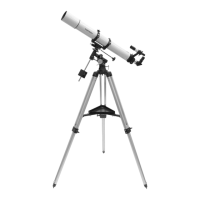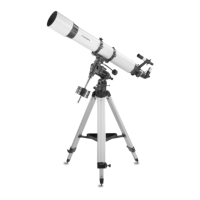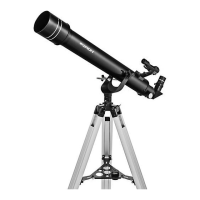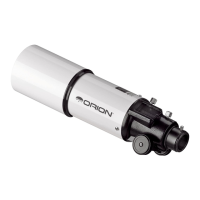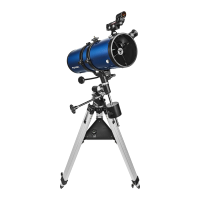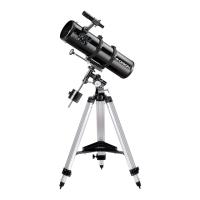4
5. Remove the knurled “toe saver” retaining screw on the
bottom of the counterweight shaft and slide both counter-
weights onto the shaft. Make sure the counterweight lock
knobs are adequately loosened to allow the counterweight
shaft to pass through the hole. Position the counterweights
about halfway up the shaft and tighten the lock knobs.
Replace the toe saver at the end of the bar. The toe saver
prevents the counterweights from falling on your foot if the
lock knobs happen to come loose.
Your Atlas EQ-G mount is now fully assembled and should
resemble Figure 1 except for the hand controller, which will be
installed and explained in Section 7.
4. Attaching a Telescope
The Atlas EQ-G equatorial mount is designed to hold tele-
scope tubes weighing up to approximately 40 lbs. For heavier
telescopes, the mount may not provide sufficient stability for
steady imaging. Any type of telescope can be mounted on the
Atlas EQ-G, including refractors, Newtonian reflectors, and
catadiotropics, provided a set of tube rings is available to cou-
ple the tube to the mount. Orion sells a variety of telescope
tube rings. Please visit our website at OrionTelescopes.com
for details.
1. Attach the tube mounting rings to the tube ring mounting
plate using the screws that come with the tube rings. The
screws should go through the center holes in the ends of
the mounting plate and rethread into the tube rings. Note
that the side of the mounting plate with the central “groove”
will be facing up (Figure 3). Use a small wrench to secure
the tube rings to the mounting plate.
Note: The tube ring mounting plate included with the Atlas
EQ-G includes four optical axis offset adjustment screws;
these are the socket head cap screws located at each cor-
ner of the mounting plate. These adjustment screws will
be explained further in Appendix A. For now, confirm that
all four adjustment screws are sufficiently unthreaded so
that the ends of their threaded shafts are flush with the
top surface of the tube ring mounting plate.
Note: The optical axis offset adjustment screws should
be oriented so that the threaded shaft extends upward
through the top surface of the tube ring mounting plate. If
the tube ring mounting plate arrives with the optical axis
offset screws installed backwards, reverse their orienta-
tion before proceeding (Figure 3).
2. Loosen the black mounting plate lock knobs on the top of
the equatorial mount. Place the mounting plate, with the
tube rings attached, in the slot on top of the equatorial
mount. Position the mounting plate so that it is centered in
the slot. Re-tighten the mounting plate lock knobs until the
plate is secure.
3. Open the tube rings and lay the telescope optical tube in
the rings at about the midpoint of the tube’s length. Rotate
the tube so that the focuser is at a convenient height for
viewing. Close the tube rings and tighten them.
Note: The Atlas EQ-G mount is very heavy. Alone it weighs
54 lbs. With a large optical tube and counterweights it can
easily weigh over 100 lbs. Keep this in mind when moving
the telescope even small distances, and use assistance
when needed. It is best to remove the optical tube and
counterweights when moving the mount.
5. Balancing a Telescope
To ensure smooth movement of a telescope on both axes of
the equatorial mount, it is imperative that the optical tube is
properly balanced. We will first balance the telescope with
respect to the right ascension (R.A.) axis, then the declination
(Dec.) axis.
1. Keeping one hand on the telescope optical tube, loosen
the R.A. lock lever. Make sure the Dec. lock lever is locked,
for now. The telescope should now be able to rotate freely
Figure 3.
The tube ring mounting plate.
Optical axis offset
adjustment screws
Figure 4a-d. Proper operation of the equatorial mount requires
that the telescope tube be balanced on the R.A. and Dec. axes. (a)
With the R.A. lock lever released, slide the counterweights down
the counterweight shaft until they just counterbalance the telescope
tube. (b) When you let go with both hands, the tube should not drift
up or down. (c) With the Dec. lock lever released, loosen the tube
ring lock clamps a few turns and slide the telescope forward or back
in the tube rings. (d) When the tube is balanced about the Dec. axis,
it will not move when you let go.
a. b.
c.
d.
Flat washer
Lock washer
Tube ring
attachment screw
